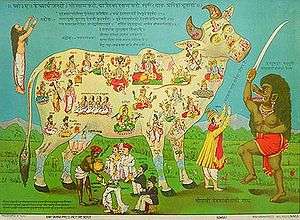Arya Vaishya
| Arya Vaishya / Komati | |
|---|---|
| Religions | Hinduism |
| Languages | Marathi, Oriya, Telugu, Kannada, Tamil |
| Populated States | Maharashtra, Odisha, Telangana, Andhra Pradesh, Karnataka, Tamil Nadu |
| Subdivisions | Gavara & Kalinga Komatis |

Arya Vaishya (Arya Vysya) or Komati is an Indian caste. Orthodox Arya Vaishyas follow rituals prescribed in the Vasavi Puranam, a religious text written in the late Middle Ages. Their kuladevata is Vasavi.
The Arya Vaishya are divided into two sub-sects, the Gavara Komatis and the Kalinga Komatis.[1] The community were formerly known as Komati Chettiars but now prefer to be referred to as Arya Vaishya.[2]
Etymology
The Komatis are said to have originally lived in large numbers along the Godavari River, which the locals called Gomati or Gomti. The Sanskrit Gomati was rendered into Telugu as Komati.[1]
Hanumantha Rao noted that the merchant classes preferred Jainism for gaining social status and respectability, and the erstwhile Banias became Gomati or followers of the Gomata cult in medieval times.[3] The story of Vasavi, the caste goddess of the Vaishyas narrated in the Vaishya Purana, is said to have definite Jain overtones.[4]
According to Rao, there is an alternative etymology for the word Komti, as the "derivation of the word from gomata, the great Jaina saint, which implies that they were followers of Gomata cult or were originally Jains".[5]
Dwarakanath Gupta says that "These tradesmen (Beharulu) who hailed from Gouda Desa took to Jainism and adopted the 'Gomata' cult. The word Gomata got distorted slowly as Gomatlu, Kommathulu, Komattulu. In the Tamil and Malayalam languages the word 'Komati' is in use. These Jain Vysyas slowly gave up Jainism and embraced the Vedic religion during its revival".[6]
Inclusion in the Vaishya varna
The Nellore Choda kings in the 13th century are said to have established the varnashrama dharma in the Telugu country. The court poet and minister Tikkana treated Komatis as being equivalent to Vaishya in his Andhra Mahabharatam.[7]
The Komati merchants along with Balijas became notable as trading communities during the period of the Vijayanagara Empire (1325-1565 CE), and desired Vaishya status.[8]
The Mackenzie manuscripts provide a record of a copper plate grant of guru Bhaskaracharya (16th century CE), given by the 102 gotras which formed the Gavara grouping. According to the Vasavi Purana, the Vaisyas of Penugonda and 17 other towns belonged to a group of Vaisyas of 714 gotras. However, the 102 gotras of Gavaras separated out, and formed the Gavara Komati community.[9]
The claim to Vaishya status was contested, legally and otherwise, during the 18th and early 19th centuries, when Niyogi Brahmins opposed attempts by Vaidiki Bramhins to adopt the orthodox Vaishya rituals. Evidence of violent encounters between the powerful Mandri Mahanad alliance, controlled by the Niyogis, and the Vaidiki community were recorded between 1780-1820 in Masulipatnam, after which the matter was sent up to a civil court. The Vaidika (Vedic) Brahmin community supported the practices of the Komatis and, after much deliberation, the court allowed the practices to continue.[8]
See also
References
- 1 2 Gupta, Dwarakanath C.; Bhaskar, S. (1992). Vysyas: a sociological study. Ashish Publishing House. ISBN 8170244501.
- ↑ Mines, Mattison (2014). "The Political Economy of Patronage, Preeminence and the State in Chennai". In Piliavsky, Anastasia. Patronage as Politics in South Asia. Cambridge University Press. ISBN 9781107056084.
- ↑ Rao, Hanumantha B. S. L., 1973. Religion in Āndhra: a survey of religious developments in Āndhra from early times upto A.D. 1325, Part 1325, Issue 69 of Archaeological series. Department of Archaeology and Museums, Government of Andhra Pradesh, p. 175
- ↑ Rao, Hanumantha B. S. L., 1995. Socio-cultural history of ancient and medieval Andhra, p.130. Volume 172 of Telugu Viśvavidyālaya pracuraṇa. Telugu University.
- ↑ Rao, B. S. L. Hanumantha. Social mobility in Medieval Andhra. p. 176.
- ↑ Gupta, C. Dwarakanath. Socio-cultural history of an Indian caste. p. 10.
- ↑ Devi, Yashoda (1993), The History of Andhra Country, 1000 A.D.-1500 A.D.: Administration, literature and society, Gyan Publishing House, pp. 290–, ISBN 978-81-212-0485-9
- 1 2 Price, Pamela G. (2000). "Conflict Processing and Political Mobilization in Nineteenth Century South India". In John Jeya Paul; Keith E. Yandell. Religion and public culture: encounters and identities in modern South India. Richmond, Surrey: Curzon Press. pp. 33–55. ISBN 9780700711017.
- ↑ Andhra Historical Research Society, 1964. Journal of the Andhra Historical Society, Volume 30, Parts 1-4, Pages 207-209.